December 2001
Sunday 2nd December 2001
I managed to get into the garage and finish off the second wheel axle assembly. I was getting the job of drilling the outline of a hole, knocking out the centre, and then filing the ragged edges smooth down to a fine art now. It took only an hour to complete the hole in the side bracket, through which the motor would poke through. I gingerly offered up this second bracket to the rest of the assembly and was relieved to find my earlier work making sure that the bearing holes were all lined up had paid off. The bearings slipped over the axle shafts without any effort at all, so I was then able to mount the second assembly onto the chassis without delay.
I thought it was time to take some more photos for the web site, so struggled my way out of the garage with the chassis hanging over my shoulder and took the following photos.
 |
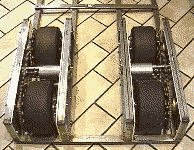 |
 |
Having nearly given myself a hernia carrying the Hog out of the garage, I wondered what it weighed. I put in on the scales and read off 51Kg (approx. 8 stone). This was just a fraction over half the total weight allowed before I have to trim bits of metal off. I will have to watch the remaining components carefully if I want to keep under the 100kg weight limit.
It's worth mentioning that I intend to change the shape of the chassis in front of the wheels a little bit. I will shorten the tubes a few inches, and will make it triangular in shape, following on from the cardboard model I made a couple of months ago.
Saturday 8th December 2001
I finished off the additions to the controller software that would switch the pneumatic valves on and off. I haven't got all the pneumatic bits yet so I wired up a few LEDs to show which valves would be operating if they were there.
Sunday 9th December 2001
I started to look at the modifications I needed to make to the chassis and decided that I might as well start making the basic chassis components from scratch rather than hacking the existing cross members about. Once I have the main parts built, I can reuse the old chassis metalwork as necessary. To my surprise, my welding was becoming a lot more consistent, and although you wouldn't call it professional quality, it didn't look at all bad. This I put down to two reasons.
First, I made sure the surfaces being welded were clean and mated closely together. Any gaps over half a millimeter stood the chance of the edges getting too hot and the metal burning, leaving a nasty hole in the join.
Secondly, holding the welding rod at 90 degrees to the surface, and only tilting it a few degrees in the direction of the weld meant the seam filled the gap evenly, and the metal stuck equally to both sides.
 |
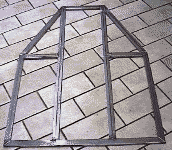 |
Sunday 30th December 2001
Over the Christmas break I managed to creep into the garage every now and then, and do some more on the chassis. By the end of Christmas it was starting to take shape, and I felt like there might be a chance of getting it ready in time for the series 6 wars.
 |
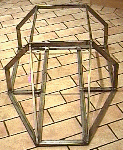 |
 |
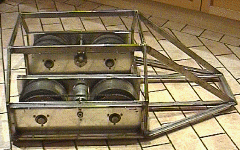 |
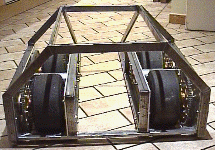 |
 |
As well as making progress on the chassis front, I was making some more progress with the pneumatics. I had been given the name of a guy Steve who sold parts for paint ball guns. He had already supplied other roboteers with pneumatic components, and knew the parts I was likely to need. He told me that there were several regulators I could use, each having good and bad points, but one feature that ran through them all was that if liquid managed to make its way through to the regulator, it would shut down and prevent most if not all of it getting any further into the systems. Additionally you could fit an "anti siphon" tube into the gas tank that would suck gas midway down the tank thereby reducing the change of sucking liquid CO2 when the robot became inverted. The physics of keeping CO2 compressed in a tank means that there is never more than about 33% liquid in the bottle, so if the tube is astutely positioned and the bottle inclined at an angle, the likelihood of you sucking liquid is further reduced.
Steve was located in Aldershot and so was not local to me. We decided that after a long phone call it was probably best for me to meet up with him one day early in January 2002 to select the most appropriate components I would need.